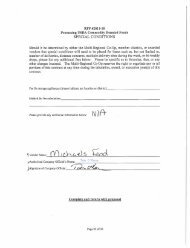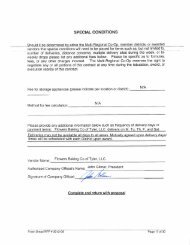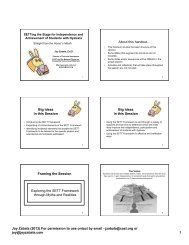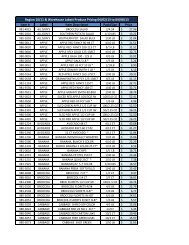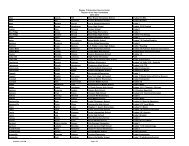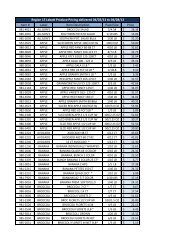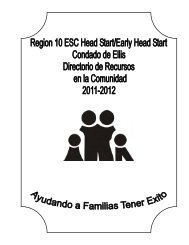Road to SMI Success Manual - Region 10 Education Service Center
Road to SMI Success Manual - Region 10 Education Service Center
Road to SMI Success Manual - Region 10 Education Service Center
Create successful ePaper yourself
Turn your PDF publications into a flip-book with our unique Google optimized e-Paper software.
Appendix O<br />
Milk Fat Comparison Chart<br />
Starting Jan. 1, 1998, the labeling of fatreduced<br />
milk products was required <strong>to</strong><br />
follow the same requirements the Food and<br />
Drug Administration (FDA) established<br />
years ago for the labeling of just about<br />
every other food reduced in fat.<br />
These products are now bound by the<br />
“general standard” for nutritionally<br />
modified standardized foods. This means<br />
the nutrients that lower-fat milk products<br />
provide, other than fat, must be at least<br />
equal <strong>to</strong> full-fat milk before vitamins A and<br />
D are added.<br />
The changes do not affect lower-fat<br />
yogurt products. FDA decided <strong>to</strong> keep the<br />
standards of identity for the time being <strong>to</strong><br />
further consider manufacturers’ concerns<br />
about fortifying yogurt with vitamin A, a<br />
nutrient found in full-fat yogurt.<br />
FDA, along with the milk industry and<br />
nutrition educa<strong>to</strong>rs, believes the label<br />
changes will give consumers more accurate,<br />
useful information about milk. Because<br />
claims on milk labels will be consistent<br />
with claims on other foods, consumers<br />
will know, for example, that “low-fat” milk<br />
(formerly known as 1 percent milk) will be<br />
similar in fat content <strong>to</strong> “low-fat” cookies.<br />
(Both can provide no more than 3 grams of<br />
fat per serving. The serving size for each<br />
is listed on their label’s Nutrition Facts<br />
panel.)<br />
The goal of the labeling changes was <strong>to</strong><br />
help consumers select milk products that<br />
can help them lower their fat and saturated<br />
fat intakes <strong>to</strong> recommended levels.<br />
Considering that 8 fluid ounces of fullfat<br />
milk provides 26 percent of the Daily<br />
Value for saturated fat, while fat-free milk<br />
provides none, switching from full-fat <strong>to</strong><br />
fat-free milk can drop saturated fat intake<br />
considerably. It’s an easy way <strong>to</strong> lower-fat<br />
intake—it doesn’t take a lot of time—no<br />
preparation skills are needed. A report<br />
of a school intervention in an inner-city,<br />
primarily Latino, school district in the city<br />
of New York involved switching from whole<br />
milk <strong>to</strong> 1% low-fat milk in 6 elementary<br />
school cafeterias. Based on the results<br />
of this switch, a 25 percent reduction in<br />
calories from saturated fat occurred, with<br />
no other dietary changes.<br />
Milk's Current Names<br />
Current names<br />
2 percent milk is now<br />
known as “reduced-fat”<br />
instead of “low-fat.”<br />
1 percent milk remains<br />
“low-fat.”<br />
milk's new names<br />
Skim retained its name<br />
or is known as fat-free,<br />
zero-fat, or non-fat milk.<br />
114



